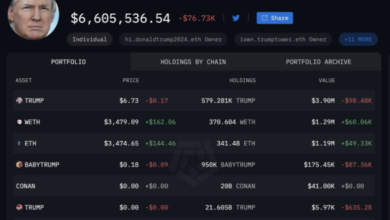
Top Crypto Trading Techniques to Maximize Your Profits
Top Crypto Trading Techniques to Maximize Your Profits is a comprehensive guide that delves into the various strategies and methods used by successful crypto traders. From fundamental analysis to advanced techniques like arbitrage, we’ll cover the entire spectrum of crypto trading, equipping you with the knowledge needed to navigate the dynamic world of digital assets. This journey will explore diverse approaches, including risk management and the crucial role of psychology in achieving consistent profits.
This in-depth exploration will cover essential aspects such as fundamental and technical analysis, order types, risk mitigation strategies, and advanced trading techniques. We will provide real-world examples, practical tips, and valuable insights into maximizing your potential in this exciting market.
Fundamental Analysis Techniques
Fundamental analysis in the cryptocurrency market involves a deep dive into the underlying factors that influence a coin’s value, moving beyond just price fluctuations. It goes beyond technical indicators and charts, delving into project viability, community strength, and market trends. This approach helps traders identify promising opportunities by understanding the intrinsic worth of a cryptocurrency, rather than simply reacting to short-term price movements.A thorough fundamental analysis requires a comprehensive understanding of the project’s whitepaper, roadmap, team, and community engagement.
By considering these factors, investors can form a more informed judgment about the long-term potential of a cryptocurrency. This method requires a nuanced understanding of the digital asset ecosystem, going beyond the superficial and focusing on the substance behind the price.
Identifying Promising Cryptocurrencies
Fundamental analysis allows investors to identify promising cryptocurrencies by evaluating their underlying strength and market position. Evaluating the project’s whitepaper, technical team, and community involvement provides a comprehensive overview. A promising cryptocurrency project should have a clear vision, a well-defined roadmap, and a passionate community actively engaged in its development and growth. Furthermore, the project’s tokenomics, or how the token is utilized and distributed, should be meticulously scrutinized.
A strong tokenomics model can incentivize participation and maintain value over time.
Market News and Community Sentiment
Market news and community sentiment play a significant role in fundamental analysis. Following industry news, regulatory updates, and announcements related to the cryptocurrency project is crucial. News regarding partnerships, integrations, and technological advancements can greatly influence a coin’s price and overall market sentiment. Similarly, observing community sentiment on social media platforms and forums offers valuable insight into the overall perception of the project.
A positive community sentiment often correlates with increased interest and demand, which can lead to price appreciation.
Metrics for Analysis, Top Crypto Trading Techniques to Maximize Your Profits
Evaluating a cryptocurrency’s fundamental aspects requires careful consideration of various metrics. These metrics provide insights into the project’s viability, its market positioning, and its long-term potential. Key factors to assess include the project’s team, its development roadmap, the utility of the token, and the overall community engagement. Understanding these metrics helps investors make more informed decisions about which cryptocurrencies to include in their portfolios.
Key Metrics to Consider
| Metric | Description | Example |
|---|---|---|
| Team | Expertise and experience of the development team. | A team with proven track records in blockchain technology. |
| Whitepaper | Clarity, completeness, and practicality of the project’s vision. | A well-structured whitepaper with realistic goals and a clear tokenomics model. |
| Roadmap | Detailed plan for the project’s development and future milestones. | A roadmap outlining specific milestones and timelines for product development and expansion. |
| Tokenomics | How the token is utilized, distributed, and governed. | A token with clear utility and a sustainable distribution mechanism. |
| Community Engagement | Active participation and engagement from the project’s community. | A vibrant community actively discussing and contributing to the project. |
| Market Cap | Total market value of the cryptocurrency. | A project with a market capitalization that reflects its potential. |
| Market Share | The project’s portion of the overall cryptocurrency market. | A project with a significant market share within its niche. |
| Adoption Rate | Number of users or applications utilizing the cryptocurrency. | A growing adoption rate indicates increasing utility and market demand. |
Technical Analysis Techniques
Technical analysis is a crucial component of crypto trading, focusing on past price and volume data to predict future price movements. Unlike fundamental analysis, which examines the intrinsic value of a cryptocurrency, technical analysis relies on patterns and indicators derived from market behavior. Understanding these patterns can provide insights into potential trends and opportunities for profitable trades. It’s important to remember that technical analysis is not a perfect science and should be used in conjunction with other strategies and risk management techniques.Technical analysis relies heavily on interpreting price charts and identifying trends.
Mastering top crypto trading techniques is crucial for maximizing profits, but robust security measures are equally vital. Understanding how to protect your crypto assets from hacks and scams, like in this insightful guide How to Protect Your Crypto Assets from Hacks and Scams , is just as important as knowing which strategies to employ. Ultimately, combining strong security practices with effective trading techniques is the key to long-term crypto success.
These trends can be categorized as upward (bullish), downward (bearish), or sideways (ranging). Recognizing these patterns, alongside the use of various technical indicators, can help traders make more informed decisions. By understanding the dynamics of price movements and identifying potential turning points, traders can potentially capitalize on profitable opportunities.
Price Charts and Trend Identification
Price charts are visual representations of price movements over time. Different chart types, such as line charts, bar charts, and candlestick charts, offer varying levels of detail. Analyzing these charts allows traders to observe trends, support and resistance levels, and potential reversal points. A rising trend is characterized by a series of higher highs and higher lows, while a falling trend is marked by lower lows and lower highs.
Identifying these patterns is a key step in technical analysis. A sideways trend is characterized by a lack of clear direction, with prices oscillating within a defined range.
Technical Indicators
Technical indicators are mathematical calculations derived from price and volume data. They provide signals to help traders understand market sentiment and potential price movements. Moving averages, Relative Strength Index (RSI), and Moving Average Convergence Divergence (MACD) are common examples. Understanding how these indicators function and interpreting their signals can be invaluable in making informed trading decisions.
Moving Averages
Moving averages smooth out price fluctuations, revealing underlying trends. They are calculated by averaging the price over a specified period. A simple moving average (SMA) is the average of the closing prices over a set number of periods. A longer-term moving average often acts as a support or resistance level, while a shorter-term moving average can help identify momentum changes.
For example, a short-term moving average crossing above a long-term moving average could signal a bullish trend.
Relative Strength Index (RSI)
The RSI measures the magnitude of recent price changes to evaluate overbought or oversold conditions. It ranges from 0 to 100, with readings above 70 often indicating an overbought condition, and readings below 30 often signifying an oversold condition. A sudden surge above 70 could suggest a potential price correction, while a sharp drop below 30 might indicate a potential reversal to a bullish trend.
Moving Average Convergence Divergence (MACD)
The MACD is a trend-following momentum indicator that uses two moving averages to identify changes in momentum. It consists of a MACD line, a signal line, and a histogram. A crossover of the MACD line above the signal line often signals a bullish trend, while a crossover below the signal line could signal a bearish trend. The histogram helps visualize the momentum difference between the two moving averages.
Candlestick Patterns
Candlestick patterns are graphical representations of price movements, providing visual cues about potential market sentiment and price changes. Patterns such as doji, hammer, engulfing patterns, and morning stars can indicate potential trend reversals or continuations. Recognizing these patterns and understanding their implications can aid in identifying profitable trading opportunities.
Comparison of Technical Indicators
| Indicator | Description | Interpretation | Strengths | Weaknesses |
|---|---|---|---|---|
| Moving Average | Average price over a period | Support/resistance, trend identification | Simple, widely used | Lagging indicator |
| RSI | Measures momentum | Overbought/oversold conditions | Identifies potential reversals | Can be noisy, requires confirmation |
| MACD | Momentum indicator | Trend changes, momentum shifts | Provides momentum signals | Can generate false signals |
Order Types and Strategies: Top Crypto Trading Techniques To Maximize Your Profits
Mastering order types is crucial for successful crypto trading. Understanding the various order types available and how to use them strategically is vital for maximizing profits and mitigating potential losses. Different order types suit various trading styles and market conditions, and implementing them effectively can significantly impact your overall trading performance.
Different Order Types in Crypto Exchanges
Order types dictate how your trades are executed. Knowing the distinctions between market orders, limit orders, and stop-loss orders is essential for managing your trades efficiently. Each order type has its own characteristics and associated risks.
- Market Orders execute immediately at the best available price. They are quick and straightforward, suitable for those who want to enter or exit a position swiftly. However, the price you get might not be ideal, especially in volatile markets.
- Limit Orders specify a price at which you want to buy or sell. They are useful for entering or exiting a position at a desired price. A limit buy order, for instance, will only be executed if the price falls to or below your specified limit. Limit orders can prevent you from buying at an unfavorable price but may not execute if the market doesn’t reach your specified price.
- Stop-Loss Orders are designed to automatically sell a security if its price drops to a certain level, preventing significant losses. They are crucial for risk management, automatically limiting potential downsides. They can be triggered at a specified price or when a price gap is met.
Trading Strategies Using Order Types
Various trading strategies can be employed using these order types. Strategies can be adapted to different market conditions, from short-term swings to long-term holdings.
- Day Trading might use market orders for quick entries and exits, capitalizing on intraday price fluctuations. Stop-loss orders are essential to limit losses if the trade turns against them.
- Swing Trading might utilize limit orders to buy or sell at predetermined target prices, capitalizing on anticipated price movements over a few days. Stop-loss orders can protect against sudden price reversals.
- Long-Term Investing might use limit orders to buy assets at a specific price, aiming for long-term growth. Stop-loss orders, though less frequent, are used to protect against substantial price drops.
Risk Management with Order Types
Risk management is crucial in any trading strategy. Implementing stop-loss orders effectively can significantly mitigate losses.
Using Stop-Loss Orders to Limit Losses
Stop-loss orders help safeguard against unforeseen market movements. A crucial aspect of effective risk management is correctly setting stop-loss orders.
Mastering top crypto trading techniques is crucial for maximizing profits, but equally important are robust security measures. Understanding how to safeguard your digital assets, like those discussed in Essential Security Practices Every Cryptocurrency Investor Should Know Today , is paramount. After all, the most profitable trading strategies are useless if your funds are compromised. So, let’s dive back into the world of effective crypto trading techniques and learn how to maximize your potential returns.
- Setting a stop-loss order at a price that is below your entry point helps protect against losses if the price unexpectedly drops.
- Determining the appropriate stop-loss price requires careful consideration of the potential for price movement and your risk tolerance.
- For instance, if you buy Bitcoin at $28,000 and set a stop-loss order at $27,000, your loss is limited to $1,000 per Bitcoin if the price falls to that level.
Examples of Stop-Loss Order Usage
Stop-loss orders are essential in risk management. They automatically sell an asset when the price reaches a predetermined level.
- If you buy Ethereum at $1,800 and set a stop-loss order at $1,700, your loss is limited to $100 per Ethereum if the price falls to that level.
- Stop-loss orders protect against significant losses by limiting potential downside risk.
Different Order Types and Their Use Cases
The table below illustrates the various order types and their typical applications.
| Order Type | Description | Use Case |
|---|---|---|
| Market Order | Executes immediately at the best available price. | Quick entries or exits, high-volume trading. |
| Limit Order | Executes only at or better than the specified price. | Entering or exiting at a desired price, price-sensitive trades. |
| Stop-Loss Order | Executes when the price reaches or falls below a specified level. | Risk management, protecting against significant losses. |
Risk Management Strategies

Source: githubassets.com
Crypto trading, while potentially lucrative, is inherently risky. Successful traders understand that maximizing profits hinges not just on astute analysis but also on effective risk management. Without a robust risk management strategy, even the most accurate predictions can lead to devastating losses. This section dives deep into essential techniques for mitigating crypto trading risks, including diversification, position sizing, stop-loss orders, and strategies for managing losses.Risk management is not merely a precaution; it’s a fundamental component of a sustainable and profitable crypto trading approach.
A well-defined strategy allows traders to navigate market volatility, protect capital, and maintain a long-term perspective. This proactive approach can translate into significant advantages, enabling traders to stay in the game, adapt to changing conditions, and ultimately achieve their financial goals within the cryptocurrency market.
Importance of Risk Management in Crypto Trading
Effective risk management in crypto trading is crucial for survival and long-term success. Uncontrolled risk exposure can lead to substantial capital loss, potentially jeopardizing the entire trading endeavor. By implementing well-defined risk management strategies, traders can protect their capital, weather market downturns, and maintain a sustainable trading approach. This proactive approach is essential for both beginners and experienced traders, ensuring they are prepared for the inherent volatility of the crypto market.
Strategies for Mitigating Potential Risks
A comprehensive risk management strategy encompasses various techniques to reduce the likelihood and impact of adverse market events. These include diversifying investments, carefully sizing positions, establishing stop-loss orders, and developing strategies for managing losses.
Diversification and Position Sizing in Crypto Trading
Diversification involves spreading investments across different cryptocurrencies, reducing reliance on a single asset. This strategy helps mitigate the impact of a single cryptocurrency’s price decline on the overall portfolio. Position sizing is equally crucial; it involves determining the appropriate amount of capital to allocate to each trade. A well-defined position sizing strategy helps traders limit potential losses while still pursuing profit opportunities.
By strategically allocating capital, traders can minimize the impact of adverse market movements on their overall portfolio. For example, a trader might allocate 5% of their portfolio to a single trade, limiting potential losses to 5%.
Importance of Setting Stop-Loss Orders
Stop-loss orders are automated trading instructions that trigger an order to sell a security when its price falls to a certain level. They serve as a critical safeguard against substantial losses. These predefined orders help traders avoid the emotional impulse to hold onto losing positions, thus mitigating the risk of significant capital erosion. By setting stop-loss orders, traders can automatically limit potential losses to a predetermined amount.
Examples of Strategies to Manage Losses
Strategies for managing losses go beyond simply setting stop-loss orders. This involves developing a plan for dealing with losing trades. This includes adjusting position sizes, reassessing trading strategies, and re-evaluating market conditions. A crucial element of this strategy is the ability to accept losses as part of the trading process. For example, if a trade results in a loss, traders can reassess the market conditions, the specific cryptocurrency’s technical indicators, and their own trading strategy to determine if further adjustments are necessary.
Summary Table of Risk Management Strategies
| Risk Management Strategy | Description | Effectiveness |
|---|---|---|
| Diversification | Distributing investments across multiple cryptocurrencies | Reduces risk of large losses from a single asset’s decline |
| Position Sizing | Allocating a specific percentage of capital to each trade | Limits potential losses per trade, protecting overall capital |
| Stop-Loss Orders | Automated orders to sell at a predetermined price | Prevents significant losses by automatically exiting losing trades |
| Loss Management Plan | Developing a plan to handle losing trades, including adjusting position sizing, re-evaluating strategies, and accepting losses | Allows traders to learn from mistakes, adapt to market conditions, and maintain a sustainable trading approach |
Advanced Trading Techniques
Advanced crypto trading techniques go beyond basic fundamental and technical analysis. They involve sophisticated strategies, often requiring a deep understanding of market dynamics and risk management. These methods can significantly enhance profitability but also increase the potential for substantial losses. Thorough due diligence and risk assessment are paramount when employing advanced techniques.
Arbitrage Opportunities
Arbitrage involves simultaneously buying and selling an asset in different markets or with different terms to profit from price discrepancies. This is predicated on the belief that the market will eventually correct the price disparity. Identifying arbitrage opportunities requires real-time market data access and sophisticated algorithms to monitor and analyze price differences across various exchanges.
- Identifying price discrepancies across different exchanges is crucial. Real-time market data feeds are essential for this. For example, if Bitcoin is priced at $29,990 on Exchange A and $30,000 on Exchange B, an arbitrage opportunity exists.
- Executing trades to capitalize on these differences requires quick reaction times. High-speed trading platforms and algorithms are frequently used to exploit these fleeting opportunities.
- Risks associated with arbitrage include rapid market changes nullifying the opportunity, and potential slippage due to high order volume, impacting profit margins.
Hedging Strategies
Hedging protects against adverse price movements. Crypto hedging involves using financial instruments to offset potential losses. Common methods include using futures contracts or options. Effective hedging requires a deep understanding of market volatility and a sound risk management strategy.
- Futures contracts allow traders to bet on the future price of an asset. Buying a Bitcoin futures contract when you anticipate a price drop can offset potential losses if the price indeed declines.
- Options provide a more flexible approach to hedging. A put option allows you to sell an asset at a predetermined price, providing protection against downward price movements.
- Hedging strategies require careful consideration of the specific market conditions and the potential impact on profits. It is crucial to understand the trade-off between potential gains and losses.
Options and Futures Contracts
Options and futures contracts offer sophisticated tools for leveraging crypto trading strategies. These tools are complex and demand a thorough understanding of the underlying contracts. A solid grasp of risk management is critical for successful implementation.
- Options contracts provide the right, but not the obligation, to buy or sell an asset at a specific price on or before a specific date. This allows traders to capitalize on potential price movements while limiting their risk.
- Futures contracts obligate the buyer and seller to complete a transaction at a future date and price. Futures contracts are used for hedging and speculation.
- Careful consideration of the expiration dates and strike prices of options contracts is crucial to avoid substantial losses. A trader should be aware of the risks involved in futures contracts, as the price fluctuations can be significant.
Advanced Technical Indicator Usage
Technical indicators provide insights into market trends. In complex trading situations, combining multiple indicators can enhance the effectiveness of analysis. However, over-reliance on indicators without fundamental analysis can lead to erroneous decisions.
- Combining moving averages, relative strength index (RSI), and volume indicators can provide a more comprehensive picture of market sentiment and potential price actions.
- Careful consideration of the timeframe for each indicator is essential, as different indicators may provide varying perspectives across different time horizons.
- Developing a robust methodology for interpreting indicator signals is essential for making informed trading decisions. This includes defining specific criteria for entry and exit points based on indicator readings.
Advanced Trading Techniques and Risks
| Technique | Description | Associated Risks |
|---|---|---|
| Arbitrage | Simultaneous buying and selling in different markets | Market fluctuations, slippage, high order volume |
| Hedging with Futures | Using futures contracts to offset potential losses | Significant price fluctuations, margin calls |
| Options Trading | Leveraging options contracts to capitalize on price movements | Time decay, loss of premium, limited profit potential |
| Complex Indicator Strategies | Combining multiple indicators for advanced analysis | Over-reliance on indicators, misinterpretation of signals |
Tools and Resources for Crypto Trading

Source: ytimg.com
Mastering crypto trading requires more than just understanding strategies. Access to reliable resources and effective tools is crucial for success. This section dives into the world of practical aids, from learning platforms to advanced charting software. Choosing the right tools can significantly enhance your trading experience and potentially boost your profits.Effective crypto trading relies heavily on the right tools and resources.
These tools can provide crucial insights, streamline analysis, and automate certain tasks, ultimately empowering traders to make informed decisions.
Looking for top crypto trading techniques to maximize your profits? Understanding market trends is key, but exploring strategies like swing trading and day trading can also significantly impact your returns. For a deeper dive into proven ways to boost your crypto investment returns in 2025, check out this helpful resource: Proven Ways to Boost Crypto Investment Returns in 2025.
Ultimately, mastering these techniques is crucial for any serious crypto trader aiming for success.
Reputable Resources for Learning
Numerous online platforms and educational resources offer valuable insights into the intricacies of crypto trading. These resources cater to various skill levels, from beginners to experienced traders. Reputable sources like educational websites, online courses, and expert-led webinars provide in-depth knowledge on crypto markets, technical analysis, and trading strategies. They also offer practical exercises and real-world examples, enabling traders to apply their knowledge effectively.
By consistently seeking knowledge from reputable sources, traders can stay updated with the evolving landscape of the crypto market.
Crypto Trading Software and Tools
A wide array of software and tools can assist traders in navigating the crypto market. These tools can automate tasks, provide real-time data, and perform complex calculations, enhancing the trading experience. Examples include charting platforms, order management systems, and risk management tools. The right selection of tools can significantly streamline the trading process, allowing traders to focus on strategy and decision-making.
Charting Platforms and Analysis Tools
Charting platforms are essential for visual analysis of market trends. These platforms typically display historical price data, volume, and other relevant indicators in graphical form. Using these tools, traders can identify patterns, support and resistance levels, and potential entry and exit points. Many platforms also offer advanced technical analysis tools, such as moving averages, oscillators, and trend lines.
By analyzing charts effectively, traders can gain a deeper understanding of market behavior and make more informed trading decisions. The key is to identify trends, potential reversals, and support/resistance levels.
Trading Position Management Platforms
Efficient management of trading positions is critical for maximizing profits and minimizing losses. Dedicated platforms can streamline this process, offering tools to track open positions, monitor market conditions, and execute trades. These platforms can also facilitate risk management by allowing traders to set stop-loss orders and profit targets. Proper management of trading positions ensures that traders remain disciplined and avoid impulsive decisions.
This is vital for long-term success in crypto trading.
Top Crypto Trading Platforms
| Platform | Key Features |
|---|---|
| Binance | Wide range of cryptocurrencies, advanced charting tools, low fees, and a vast community |
| Coinbase Pro | Robust charting and order types, user-friendly interface, and excellent security |
| Kraken | Excellent for institutional investors, strong security measures, and a wide range of cryptocurrencies |
| KuCoin | Diverse selection of cryptocurrencies, competitive trading fees, and active community |
| Gemini | User-friendly interface, strong security, and a focus on institutional investors |
Final Conclusion
In conclusion, mastering crypto trading requires a multifaceted approach encompassing various techniques and strategies. This guide has explored the fundamentals, from analyzing market trends to managing risks effectively. By combining fundamental and technical analysis, utilizing appropriate order types, and employing sound risk management, traders can significantly increase their chances of success. Ultimately, understanding the psychological aspects of trading is as crucial as the technical skills.
Remember, consistent profits stem from a combination of knowledge, discipline, and emotional intelligence.
FAQ
What is the difference between day trading and swing trading?
Day trading involves holding positions for a short period, typically within a single trading day, while swing trading holds positions for several days or weeks. Day trading often requires more frequent monitoring and technical analysis, while swing trading might allow for a broader range of strategies and asset selection.
How can I manage my risk in crypto trading?
Effective risk management is crucial. Diversification across different cryptocurrencies and asset classes, appropriate position sizing, and setting stop-loss orders are all essential strategies. It’s also important to avoid emotional decisions and stick to your trading plan.
What are some common psychological pitfalls in crypto trading?
Fear of missing out (FOMO), greed, and overconfidence are common pitfalls. Understanding and managing these emotions can significantly improve trading outcomes. Developing a disciplined trading plan and sticking to it is key.
Are there resources to learn about advanced trading techniques?
Yes, there are many reputable resources like online courses, educational websites, and forums dedicated to crypto trading. Joining communities of experienced traders and staying informed about market trends can be beneficial.






